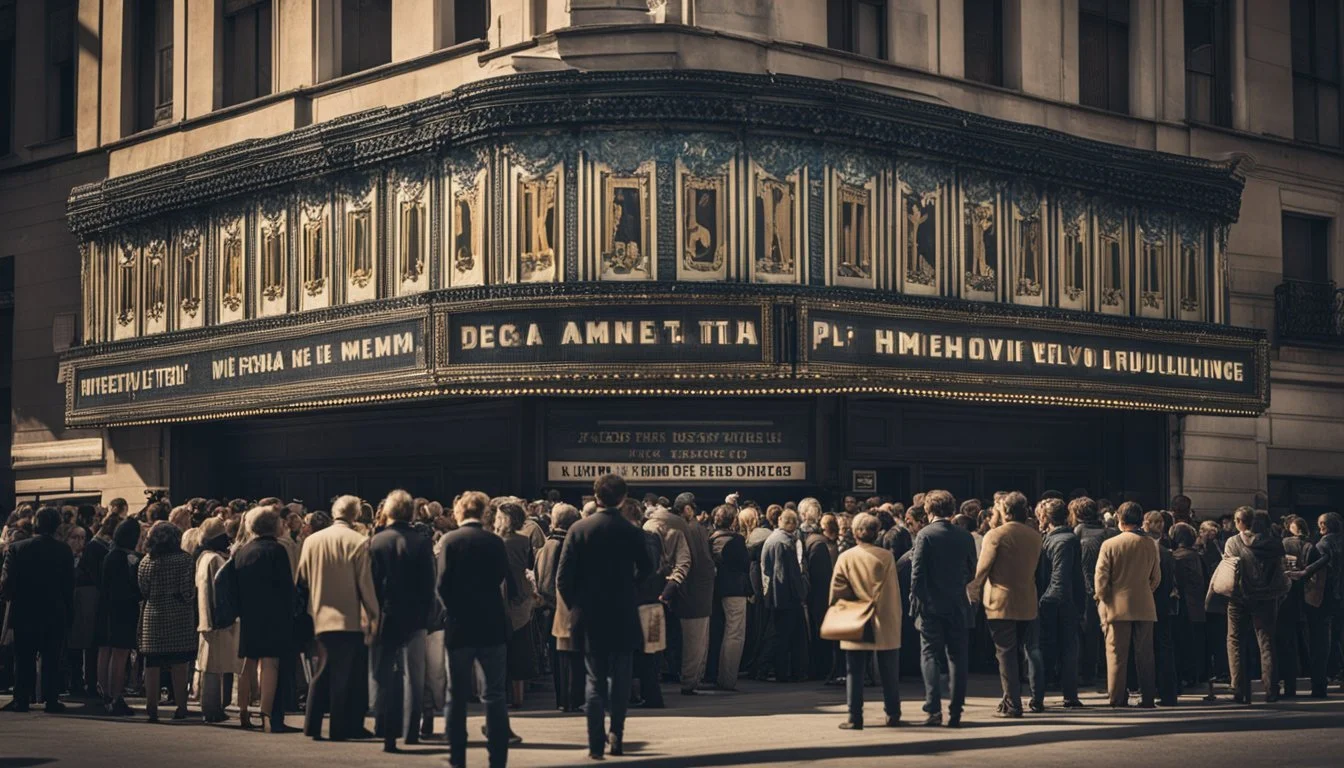Dziga Vertov: Revolutionizing the Language of Cinema in the 20th Century
Dziga Vertov, born David Kaufman, stands as one of the most influential figures in the history of cinema. His work, especially Man with a Movie Camera (1929), demonstrates a pioneering approach to documentary filmmaking that broke away from traditional narrative forms. Vertov's vision was to create a new visual language—what he termed "Kino-Eye"—that reflected life as it is, free from theatrical manipulation.
Vertov's innovative techniques, such as dynamic visual compositions and inventive editing, are now considered foundational in the field of cinéma vérité. His dedication to the art of filmmaking was driven by his belief in the power of the camera to capture reality and reveal deeper truths about the human experience. Vertov's work continues to be studied and celebrated for its groundbreaking explorations and impact on modern documentary practices.
As you explore the lasting impact of Dziga Vertov’s methodologies, it becomes clear why he is often hailed as cinema's greatest innovator of the nonfiction film. His contributions set a benchmark for future generations of filmmakers who aspire to push beyond the boundaries of conventional storytelling.
Early Life and Career of Dziga Vertov
Dziga Vertov, born David Abelevich Kaufman on January 2, 1896, in Belostok, Russia, played a pivotal role in early Soviet cinema.
He later adopted the name Denis Kaufman and ultimately became known as Dziga Vertov. This pseudonym means "spinning top" in Ukrainian.
Vertov initially studied music and medicine before pivoting to cinema.
He started his career in film as a newsreel editor for the Soviet government. He quickly became a key figure in Soviet propaganda through documentary film.
Vertov joined the Kino-Pravda (Film Truth) newsreel series in 1922, where he began developing his radical theories on filmmaking.
His concept of Kino-Eye proposed that the camera, like the human eye, should explore real-world happenings without bias.
Vertov believed cinema could reveal hidden truths, inaccessible to the naked eye. This philosophy underpinned much of his early work and contributed to his distinctive style.
He used innovative techniques, such as editing for emotional impact and seeking to depict "life as it is" rather than staged scenes.
Vertov’s early films, like "The Anniversary of the Revolution" (1918) and "The Eleventh Year" (1928), reflect his dedication to capturing real events with an unflinching lens.
In 1929, he directed "Man with a Movie Camera," a groundbreaking work that showcased his full array of experimental techniques and remains influential to this day.
Throughout his career, Vertov's dedication to cinéma vérité and his refusal to conform to conventional cinematic norms marked him as a pioneering figure in documentary filmmaking.
The Kino-Eye Philosophy
Dziga Vertov's Kino-Eye philosophy redefined filmmaking by emphasizing the objective capturing of reality and integrating constructivist principles into cinema. This approach aimed to depict life as it is, unconstrained by traditional narrative techniques.
Theory of Cinematic Truth
Vertov believed that traditional narrative cinema failed to capture the true essence of human experience. He coined the term "Kino-Eye" to describe his technique, which utilized mechanical recording devices to present a more truthful depiction of reality.
By employing innovative editing techniques, Vertov aimed to reveal deeper truths hidden within everyday life. His work sought to transcend human limitations, providing audiences with an unmediated view of the world through the lens of the camera. This principle was foundational to projects like Man with a Movie Camera.
Vertov's emphasis on capturing "life unawares" resulted in the use of candid footage and non-actors, aiming for authenticity. He saw the camera as a powerful tool for enlightenment, enabling a new form of artistic expression rooted in objectivity.
Influence of Constructivism
Constructivism profoundly influenced Vertov's Kino-Eye philosophy. This artistic and architectural movement, prominent in post-revolutionary Soviet Union, valued function, abstraction, and modern technology. Vertov integrated these ideas into his cinematic practice.
The constructivist elements in Vertov's work include the use of dynamic, avant-garde montages and the focus on industrial and urban subject matter. His films often showcased machinery, labor, and modern life, reflecting constructivist ideals of progress and innovation.
Additionally, his structured, almost mathematical approach to filmmaking aligned with constructivist principles. By seeing film editing as a form of construction, Vertov reshaped the visual language of cinema to highlight societal transformations and the possibilities brought by the new socialist reality.
Revolutionary Film Techniques
Dziga Vertov revolutionized cinema through innovative techniques such as cinematic montage, hidden cameras, and unique film editing methods. These techniques not only challenged the conventions of his time but also laid the groundwork for future developments in documentary filmmaking.
Cinematic Montage
Vertov's use of cinematic montage was pioneering. He believed that editing was essential for creating meaning in film. By juxtaposing unrelated shots, he could evoke new ideas and emotions.
In Man with a Movie Camera (1929), Vertov used montage to show the interconnectedness of urban life. Quick cuts between factories, street scenes, and workers created a dynamic rhythm. This approach influenced later filmmakers, showcasing how editing could shape a film’s narrative and emotional impact.
Use of Hidden Cameras
Hidden cameras played a crucial role in Vertov's work. He aimed to capture authentic, un-staged moments, breaking from traditional, scripted cinema. This technique brought an element of raw realism to his films.
By placing cameras discreetly, Vertov filmed people unaware they were being recorded, thus preserving their natural behavior. This approach was evident in Kinopravda (1922-1925), where everyday Soviet life was depicted without artifice. Vertov's commitment to unmediated truth helped to pave the way for the cinéma vérité movement.
Experiments with Film Editing
Vertov's experiments with film editing pushed boundaries. He explored how editing could manipulate time and space, enhancing the viewer's experience. His approach was not just about continuity but creating a cinematic language.
In The Eleventh Year (1928), Vertov used techniques like split screens, superimpositions, and slow motion to intensify the narrative. These innovations allowed him to present multiple perspectives and deepen the storytelling. Vertov’s editing style emphasized the role of the filmmaker as an interpreter rather than a mere recorder of reality.
Major Works and Contributions
Dziga Vertov's contributions to cinema revolutionized the documentary form with his innovative techniques and theories. His works like The Man with a Movie Camera, the Kino-Pravda series, and Enthusiasm: Symphony of the Donbass set new standards for film-making.
The Man with a Movie Camera
The Man with a Movie Camera (1929) is one of Vertov's most acclaimed films. It captures urban life in various Soviet cities with groundbreaking film techniques.
Vertov used rapid montages, Dutch angles, and split screens to create a dynamic narrative. The film illustrates the concept of "cine-eye," showing that the camera could capture reality more effectively than the human eye. This work remains influential for its visual creativity and technical mastery.
Kino-Pravda Series
The Kino-Pravda series (1922–1925) consisted of 23 newsreels that documented daily Soviet life. It introduced the idea of capturing reality without the influence of traditional storytelling.
Vertov's "life as it is" motto underpinned these films, eschewing staged events. Techniques such as hidden cameras and candid shots were employed to present an unedited view of Soviet society. This series laid the groundwork for modern documentary practices.
Enthusiasm: Symphony of the Donbass
Enthusiasm: Symphony of the Donbass (1931) is noted for its pioneering use of sound. It was Vertov’s first sound film and highlighted industrialization in the Donbass region of Ukraine.
In this film, Vertov synchronized sound and visual elements, creating an audiovisual experience that celebrated Soviet progress. The use of natural sounds and machinery noises alongside music reflected the dynamic energy of the era, showcasing Vertov's ability to innovate in both visual and auditory realms.
International Recognition and Influence
Dziga Vertov's pioneering techniques and theories have had a profound impact on documentary filmmaking and non-fiction cinema. His innovative approaches continue to shape these fields globally.
Impact on Documentary Filmmaking
Dziga Vertov's work has revolutionized documentary filmmaking. His film "Man with a Movie Camera" (1929) utilized inventive editing techniques and camera angles, which broke away from traditional cinematic forms. Vertov’s emphasis on capturing "life as it is" influenced a generation of documentary filmmakers.
His concept of the Kino-Eye, emphasizing objective reality using innovative techniques like montage, inspired documentarians to explore new ways of visual storytelling. This approach underscored the potential of documentary films to be more than mere chronicles, but profound examinations of reality.
Legacy in Non-Fiction Cinema
Vertov's legacy in non-fiction cinema is substantial. His films not only documented real events but also experimented with the medium to present a deeper truth. Techniques such as jump cuts and time-lapse photography first popularized by Vertov are now staples in non-fiction cinema.
The ideas Vertov advocated continue to resonate. Modern filmmakers like Michael Moore and Werner Herzog embody his spirit, pushing the boundaries of non-fiction film. Vertov’s insistence on the filmmaker being both a creative and factual commentator created a blueprint followed by many in the genre today.


